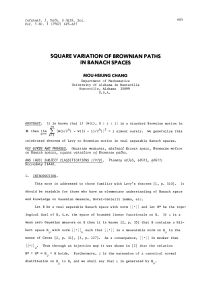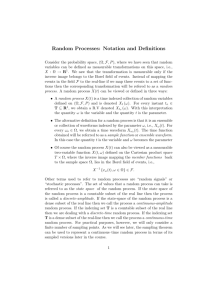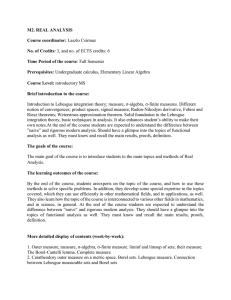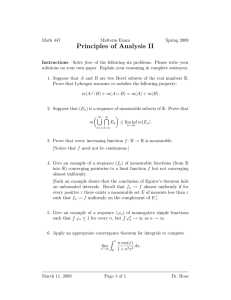Measurability of linear operators in the Skorokhod topology 1 Introduction and notation.
advertisement
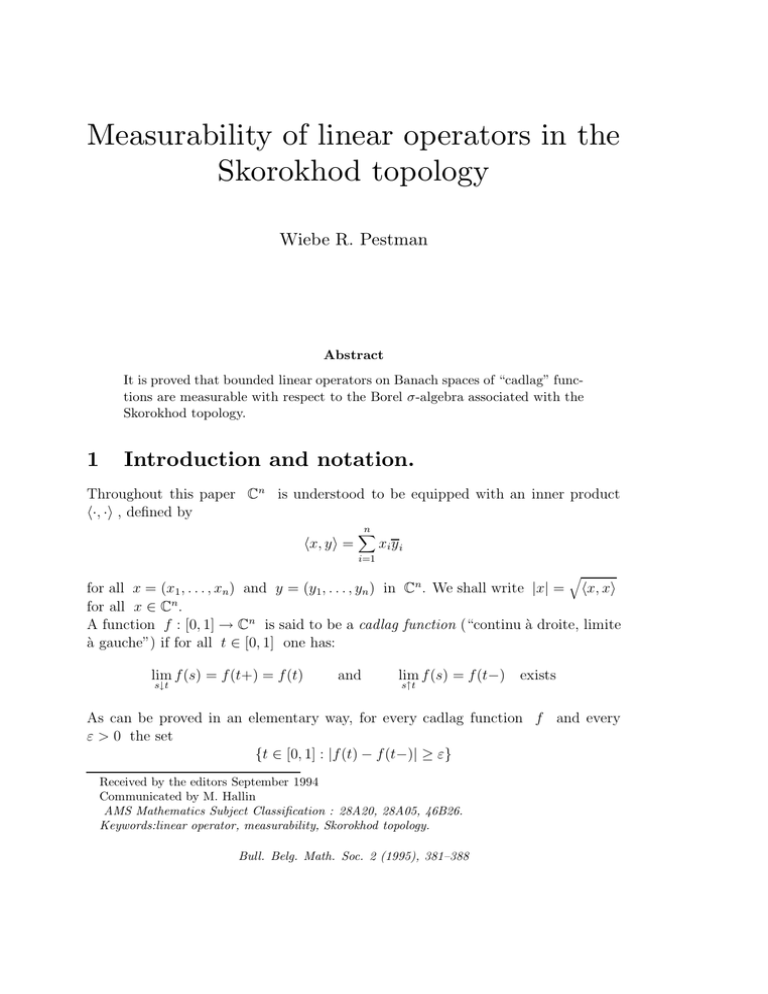
Measurability of linear operators in the
Skorokhod topology
Wiebe R. Pestman
Abstract
It is proved that bounded linear operators on Banach spaces of “cadlag” functions are measurable with respect to the Borel σ-algebra associated with the
Skorokhod topology.
1
Introduction and notation.
Throughout this paper Cn is understood to be equipped with an inner product
h·, ·i , defined by
hx, yi =
n
X
xi y i
i=1
q
for all x = (x1 , . . . , xn ) and y = (y1, . . . , yn ) in Cn . We shall write |x| = hx, xi
for all x ∈ Cn .
A function f : [0, 1] → Cn is said to be a cadlag function (“continu à droite, limite
à gauche”) if for all t ∈ [0, 1] one has:
lim f(s) = f(t+) = f(t)
s↓t
and
lim f(s) = f(t−) exists
s↑t
As can be proved in an elementary way, for every cadlag function f and every
ε > 0 the set
{t ∈ [0, 1] : |f(t) − f(t−)| ≥ ε}
Received by the editors September 1994
Communicated by M. Hallin
AMS Mathematics Subject Classification : 28A20, 28A05, 46B26.
Keywords:linear operator, measurability, Skorokhod topology.
Bull. Belg. Math. Soc. 2 (1995), 381–388
382
W. R. Pestman
is finite. It follows from this that a cadlag function can be uniformly approximated
by step functions on [0, 1]. Consequently, every cadlag function is a bounded Borel
function. The linear space of all cadlag functions assuming values in Cn will be
denoted by D(Cn ) or, if there can be no confusion, simply by D.
Now D is equipped with the supremum norm k•k :
kfk = sup{|f(t)| : t ∈ [0, 1]}
In this way D becomes a non-separable Banach space, we shall denote it by DB .
In [8] and [9] Skorokhod introduced on D a weaker topology which turns it into a
Polish space. We shall refer to this topology as the Skorokhod topology. The space
D , equipped with this topology, will be denoted by DS .
It can be proved (see Billingsley [1]) that the identity map I : DS → DB is
continuous in every f which is continuous on [0, 1]. In particular I is continuous
in the origin.
The map I is of course not continuous everywhere on DS . It thus appears that the
topology on DS is not translation invariant; consequently DS is not a topological
vector space.
Although the Skorokhod topology is not compatible with the linear structure on
D, the corresponding Borel σ-algebra is. In fact we shall see (theorem 3) that it
presents the “cylindrical” σ-algebra on the Banach space DB .
In the sequel the only thing that we shall need in connection to the Skorokhod
topology is that for all t ∈ [0, 1] the map
f → f(t)
is a Borel function on DS (see Billingsley [1]).
It follows from this that for all t ∈ [0, 1] the map
1
f → f(t−) = lim f(t− ) ,
n→∞
n
being the pointwise limit of a sequence of Borel functions, is also a Borel function
on DS .
2
The dual space of the Banach space DB
In this section we are going to study the structure of continuous linear forms on
DB (Cn ), that is, we are going to describe the dual space D∗B of DB (see also
Corson [2]).
For any index set I and any ϕ : I → Cn we define:
X
a∈I
If
P
a∈I
|ϕ(a)| = sup{
X
|ϕ(a)| : F a finite subset of I}
a∈F
|ϕ(a)| < +∞ , then the limit
lim
F
X
a∈F
ϕ(a) =
X
a∈I
ϕ(a)
Measurability of linear operators in the Skorokhod topology.
383
exists in Cn , where the filtration on the collection of finite sets F is understood
to be defined by inclusion.
P
The set of all ϕ : I → Cn such that
a∈I |ϕ(a)| < +∞ will be denoted by
`1 (I, Cn ).
If m1, . . . , mn are complex Borel measures on [0, 1] then we shall write:
m = (m1 , . . . , mn )
For all m and all ϕ ∈ `1 ([0, 1], Cn ) we define a map [m, ϕ] : D → C by:
[m, ϕ](f) =
n Z
X
fi d mi +
i=1
X
hf(a) − f(a−), ϕ(a)i ,
a∈[0,1]
where f = (f1 , . . . , fn ) ∈ D(Cn ).
The following theorem is stated in the notations introduced above:
Theorem 1. (i) For all m = (m1 , . . . , mn ) and ϕ ∈ `1 ([0, 1], Cn ) the map
[m, ϕ] : DB (Cn ) → C is a continuous linear form.
(ii) For every continuous linear form l on the Banach space DB (Cn ) there exists
a unique m = (m1 , . . . , mn ) and a unique ϕ ∈ `1 ([0, 1], Cn ) such that l = [m, ϕ].
Proof. The proof of (i) is left to the reader.
We prove statement (ii) in the case where n = 1. The general case can easily be
deduced from this, for DB (Cn ) is in an obvious way the direct sum of copies of
DB (C).
Let l be an arbitrary continuous linear form on DB = DB (C). By Riesz’s
representation theorem the restriction of l to the subspace C([0, 1]) of continuous
functions on [0, 1] defines a complex Borel measure on [0, 1]. This measure will be
denoted by m.
The continuous linear form el on DB is defined by
e
l(f)
= l(f) −
Z
f dm
for all f ∈ D
Now one has el(f) = 0 for every f ∈ C([0, 1]).
For every finite set F ⊂ [0, 1] we define the linear subspace MF by:
MF = {f ∈ D : f(a) − f(a−) = 0 if a ∈
/ F}
In other words, MF comprises those f ∈ D which have a possible jump in the
points of F only.
For every a ∈ (0, 1] and sufficiently small δ > 0 we define the function 1δa by:
1δa(t) = 1δ (t−a+δ)
=0
if t ∈ (a−δ, a)
elsewhere on [0, 1]
If f ∈ MF , then for sufficiently small δ > 0 the function
f+
X
a∈F
{f(a) − f(a−)} 1δa
)
384
W. R. Pestman
is an element of C([0, 1]). Therefore:
e
l f+
X
!
{f(a) − f(a−)}
1δa
=0
a∈F
Consequently we have for all f ∈ MF
e
l(f) = −
X
{f(a) − f(a−)} el(1δa )
a∈F
Keeping a fixed, the difference of two functions of type 1δa is in C[0, 1]. We see
e δ ) does not depend on δ.
in this way that the expression l(1
a
e δ ). We then have:
For every a ∈ [0, 1], define ϕ(a) = − l(1
a
e
l(f)
=
X
ϕ(a){f(a) − f(a−)}
for all f ∈ MF
a∈F
Our next goal is to prove that ϕ ∈ `1 ([0, 1], C). For every finite F ⊂ [0, 1] we
define the “complex saw tooth function” fF in the following way:
• fF (a) =
• fF (a) =
ϕ(a)
if a ∈ F and ϕ(a) 6= 0
|ϕ(a)|
if a ∈ F and ϕ(a) = 0
1
• fF is a linear function on each connected component of F c, such that for all
a ∈ F one has fF (a+) = fF (a) and fF (a−) = 0
Now kfF k ≤ 1 for all F . Therefore we have:
sup
F
X
|ϕ(a)| = sup |el(fF )| < +∞
F
a∈F
It follows from this that ϕ ∈ `1 ([0, 1], C) , so the map
X
f →
{f(a) − f(a−)} ϕ(a)
a∈[0,1]
is continuous on DB .
S
For all f ∈ MF we have
F
e
l(f) =
X
{f(a) − f(a−)} ϕ(a)
(∗)
a∈[0,1]
S
MF being dense in DB , this implies that (∗) holds for all
The linear space
f ∈ DB . In this way we see, by definition of le , that l = [m, ϕ].
Unicity of m and ϕ can be proved easily; this is left to the reader.
Measurability of linear operators in the Skorokhod topology.
385
Next, let Ω be an arbitrary set, F a σ-algebra of subsets of Ω and M a
topological space. A map X : Ω → M is said to be F -measurable (or simply
measurable if no confusion can arise) if X −1 (A) ∈ F for all Borel sets A in M.
If M is a Banach space then a map X : Ω → M is said to be scalarly measurable
if for every continuous linear form l on M the composition l ◦ X : Ω → C is
measurable. A well-known theorem in functional analysis (due to B.J. Pettis [6])
states that in case of a separable Banach space, measurability is equivalent to scalar
measurability. If M is non-separable then this statement is in general not true. In
fact, it is easy to construct a counterexample in case M = DB (C):
Example. Let Ω = [0, 1] and let F be the σ-algebra consisting of all Borel sets
in [0, 1]. Define X : Ω → DB (C) by:
for all s ∈ [0, 1]
X(s) = 1[0,s)
For any continuous linear form l = [m, ϕ] we have:
l(X(s)) = m{[0, s)} + ϕ(s)
for all s ∈ [0, 1]
P
The condition that
a |ϕ(a)| < +∞ implies that the set of points s for which
ϕ(s) 6= 0 is at most countably infinite. Keeping this in mind, measurability of the
map s → l(X(s)) can be proved by easy verification. It thus appears that X is
scalarly measurable.
Next we are going to prove that X : Ω → DB is not measurable.
Let A ⊂ [0, 1] be a set which is not Borel. Define
A = {1[0,s) : s ∈ A} ⊂ DB
Denote the convex hull of A by C . It is not hard to prove that for all t 6∈ A
k1[0,t) − fk ≥
1
2
for every f ∈ C , and consequently also for every f in the closure C of C in DB .
In this way it turns out that X −1 (C) = A. This shows that X is neither measurable
in the norm, nor in the weak topology associated with the Banach space DB . (To
the author it is not known whether the Borel σ-algebras corresponding to the norm
and the weak topology on DB really differ (see also Edgar [3]). Talagrand proved
in [10] and [11] the existence of Banach spaces where both σ-algebras are different).
3
Measurability in the Skorokhod topology.
As announced earlier, the linear space D equipped with the Skorokhod topology
will be denoted by DS . A map X : DS → M , where M is a topological space, is
said to be measurable if it is measurable with respect to the Borel σ-algebra of DS .
Theorem 2. Let l be a continuous linear form on the Banach space DB (Cn ).
Then l : DS (Cn ) → C is measurable.
386
W. R. Pestman
Proof. The proof is split up into three steps.
If f = (f1 , . . . , fn ) ∈ D(Cn ) and m = (m1, . . . , mn ) where m1 , . . . , mn are
complex Borel measures on [0, 1], then we shall write
Z
hf, dmi =
n Z
X
fj d mj
j=1
step 1: If δa is the Dirac measure in the point a and if c = (c1 , . . . , cn ) ∈ Cn ,
then we denote
m = cδa = (c1 δa, . . . , cn δa)
It is known that the map f → f(a) is measurable on DS (see Billingsley [1]), so
it follows that, in case m = cδa , the map
f→
Z
hf, dmi = hf(a), ci
is also measurable on DS .
step 2: Next we are going to prove that for arbitrary complex measures m1, . . . , mn
on [0, 1] the map
f→
Z
hf, dmi
is measurable on DS .
For every k ∈ N we define the 2k intervals Iik by
Iik = [(i − 1)/2k , i/2k )
i = 1, 2, . . . , 2k
Moreover, for every f ∈ D a sequence fk ∈ D is defined by:
k
2
X
fk = f(i/2k )1I k + f(1) 1{1}
i=1
i
Now if k → ∞ one has (because f(t+) = f(t) ) that fk (t) → f(t) for every
t ∈ [0, 1].
For all Borel sets A ⊂ [0, 1] we write
m(A) = (m1(A), . . . , mn (A))
and we define
k
2
X
mk = m(Iik ) δi/2k + m({1})δ1
i=1
Then
Z
k
hf, dmk i =
2
X
i=1
hf(i/2k ), m(Iik )i + hf(1), m{1}i =
Z
hfk , dmi
Measurability of linear operators in the Skorokhod topology.
387
So by Lebesgue’s bounded convergence theorem, we have for all f ∈ D
Z
hf, dmi = lim
k→∞
By step 1 the maps
f→
Z
Z
hf, dmk i
hf, dmk i
are measurable on DS . It follows from this that the map
f →
Z
hf, dmi ,
being the pointwise limit of a sequence of measurable maps, is measurable on DS .
step 3: If ϕ ∈ `1 ([0, 1], Cn ) then the map
f →
X
hf(a) − f(a−), ϕ(a)i
a∈[0,1]
is measurable on DS .
To prove this, we observe that the set {a | ϕ(a) 6= 0} is at most countably infinite.
Measurability is now easily verified, for the maps
f → f(a)
and
f → f(a−)
are measurable on DS .
Finally, by step 2, step 3, and theorem 1 we conclude that every continuous linear
form on DB is measurable on DS . This proves the theorem.
The following theorem gives a characterization of the Borel σ-algebra of DS .
Theorem 3. The Borel σ-algebra of DS is generated by the maps l : DS → C ,
where l ∈ D∗B .
Proof. This is a direct consequence of theorem 2 and the fact that the maps of
type f → f(a) generate the Borel σ-algebra of DS (see Billingsley [1] or apply
Fernique’s theorem, see Schwartz [7]).
The theorem above enables us to prove:
Theorem 4. If T : DB (Cm ) → DB (Cn ) is a bounded linear operator then
T : DS (Cm ) → DS (Cn ) is measurable.
Proof. To prove that T : DS (Cm ) → DS (Cn ) is measurable it is, by theorem 3,
sufficient to prove that for all l ∈ D∗B (Cn ) the composition l ◦ T : DS (Cm ) → C
is measurable. This is trivial, because l ◦ T ∈ D∗B (Cm ).
Closing remarks
In stochastic analysis one is sometimes encountered with variables assuming values
in DS . By theorem 3, measurability of such variables is equivalent to scalar measurability with respect to the Banach space DB . There is no loss of measurability if
bounded linear transformations are applied (see for example J. Kormos e.a. [4] or
T. van der Meer [5]).
388
W. R. Pestman
References
[1] P. Billingsley, Convergence of probability measures (John Wiley & Sons, New
York, 1968).
[2] H.H. Corson, The weak topology on a Banach space, T.A.M.S., vol 101 (1961),
p.1-15.
[3] G.A. Edgar, Measurability in a Banach space, Ind. Univ. Math. Journ., vol 26
(1977), p.663-667.
[4] J. Kormos, T. van der Meer, G. Pap, M. van Zuijlen, Asymptotic inference of
nearly non-stationary complex-valued AR(1) processes, Report 9351, University of Nijmegen, the Netherlands.
[5] T. van der Meer, Applications of operators in nearly unstable models, thesis
University of Nijmegen, the Netherlands (1995).
[6] B.J. Pettis, On integration in vector spaces, T.A.M.S., vol. 44 (1938), p.277-304.
[7] L. Schwartz, Radon measures on arbitrary topological spaces and cylindrical
measures (Oxford University Press, London, 1973).
[8] A.V. Skorokhod, Dokl. Akad. Nauk SSSR, 104 (1955) p.364-367.
[9] A.V. Skorokhod, Dokl. Akad. Nauk SSSR, 106 (1956) p.781-784.
[10] M. Talagrand, Comparaison des Boreliens pour les topologies fortes et faibles,
Ind. Univ. Math. Journ., vol. 21 (1978), p.1001-1004.
[11] M. Talagrand, Pettis integral and measure theory, Memoirs of the A.M.S.,
vol. 51, nr. 307 (1984).
Wiebe R. Pestman
Department of Mathematics,
University of Nijmegen,
Toernooiveld,
6525 ED Nijmegen,
The Netherlands.

